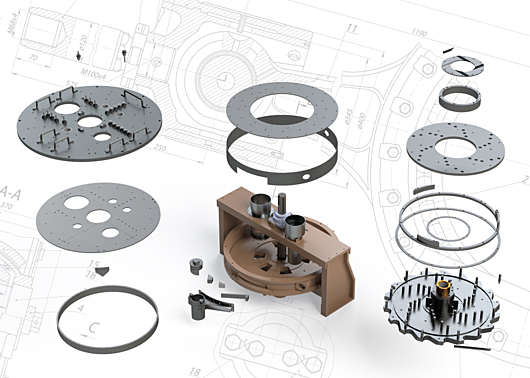
A gypsum pin mixer is more than a machine. It’s like a model of a sci-fi metropolis, with different layers and structures and tiny, intricate parts that work together to mix your slurry. No hovercars, though.
Mixers are made with dozens of moving parts — you can see 22 of them in our interactive 3D model. Everything is there to ensure your gypsum slurry gets mixed properly with fewer lumps and bumps.
At ACS Mixers, all parts big and small are machined with precision. But what do all these parts actually do? We can’t cover every single one in a blog, so let’s take a look at three heavy-hitters.
What role do rotor pins serve?
It’s all about agitation. Rotor pins work in unison with lid pins to agitate the stucco and powdered additives to help them combine with the water and liquid additives. Together they help to create a smooth, lump-free gypsum slurry.
You can get even better agitation by enlarging the lid pins to help them mesh even more closely to the rotor pin.
What about the lid lump ring?
The lid lump ring helps control the flow of slurry mix through the mixer. As slurry flows through, the lump ring holds back any material lumps that are larger than its rotor clearances.
By holding back the flow, the lump ring also helps the rotor and lid pins do their job in the desired area of the mixer, meaning the lumps get broken down before they pass through.
Why do I need a properly-sized mixer gate assembly?
Proper sizing helps the material flow when and where it’s supposed to. When the mixer gate assembly is sized properly, it helps the slurry stay inside the mixer and keep the internal area full, which is another aspect of minimizing lumps.
The assembly also helps foam transition smoothly through the gate mud slide and canister, which can greatly enhance the quality of foam / slurry as it comes out onto the mixing table.
Correctly choosing these parts and accessories can dramatically enhance your product:
- Wedge Tip
- Gate Vortex
- Spiral Size and Settings
- Boot
- Foam Inlet
The importance of maintenance
A little bit of time invested in maintenance each week can save you a lot of money. To keep your slurry smooth, prevent paper breaks and keep your gypsum mixer running longer, we always recommend keeping a regular maintenance schedule.
Take a look at our weekly and monthly maintenance tips to see what types of checks you should be doing.
Phew. Taking apart mixers is a lot of work!
You’re right. Let’s take a break and mix something fun: a cool, summery spin on a classic cocktail. It looks a bit like gypsum slurry (off-white and slushy), but it tastes much better.
Frozen Tommy’s Margarita
- 2 oz tequila (pref. reposado)
- 1 oz lime juice
- ¾ oz agave syrup
- 1 cup crushed ice
Blend it all together, pour into a glass and garnish with a lime wedge.
Now that you’re feeling refreshed, give us a call to discuss any other gypsum mixer questions you might have. Cheers!
